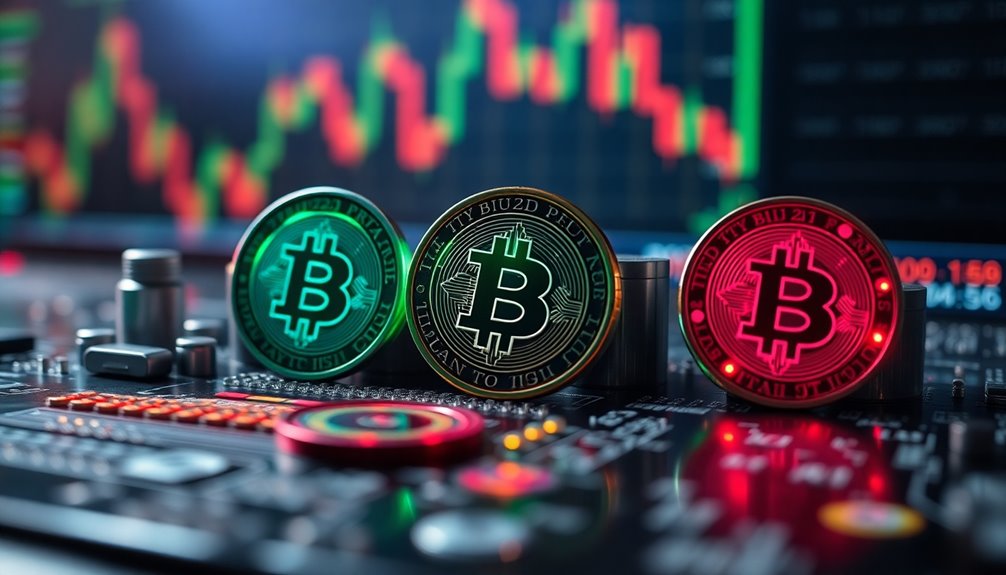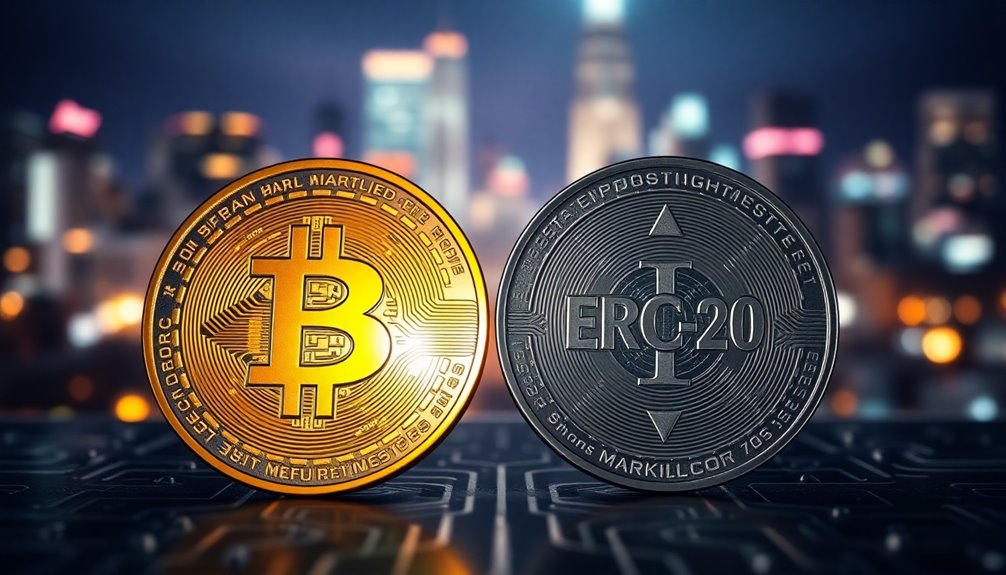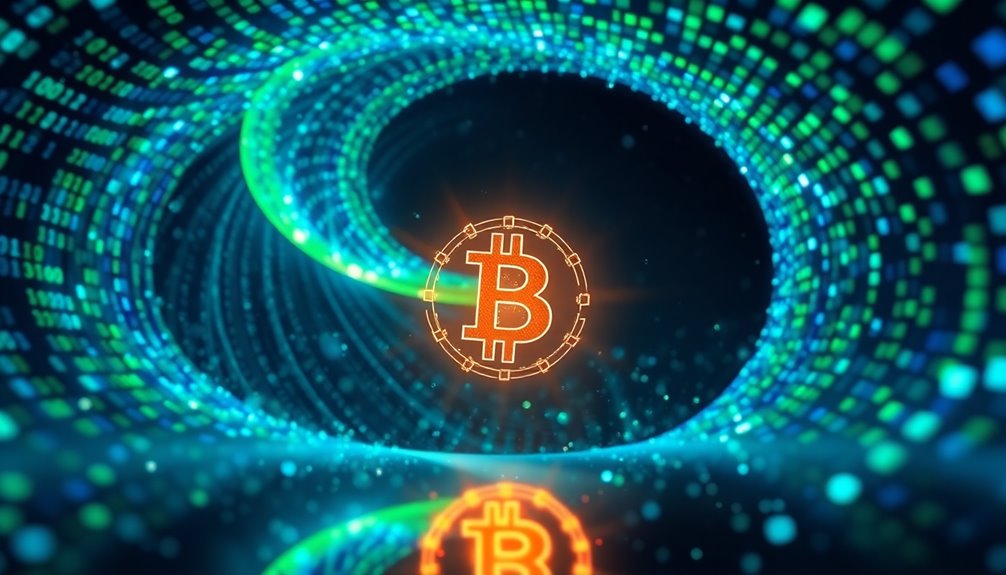BRC-20 is a token standard on the Bitcoin blockchain that boosts its capability for decentralized applications, similar to Ethereum's ERC-20 standard. Introduced in March 2023, these semi-fungible tokens use ordinal inscriptions, allowing for trading in fixed increments. You'll find BRC-20 tokens secure, leveraging Bitcoin's robust Proof-of-Work mechanism to prevent hacks. With nearly 25,000 tokens launched, the market's interest is clear. While they offer various applications—like real-world asset tokenization—they come with certain limitations. If you stick around, you'll discover the unique advantages and challenges these tokens present.
Key Takeaways
- BRC-20 is a token standard on the Bitcoin blockchain, enhancing its functionality for decentralized applications since March 2023.
- It allows for semi-fungible tokens created using ordinal inscriptions, making them fungible and interchangeable.
- The BRC-20 minting process involves storing JSON data on satoshis without smart contracts, differing from Ethereum's ERC-20.
- It benefits from Bitcoin's security and robust Proof-of-Work consensus mechanism, though it faces limitations in smart contract functionality.
- BRC-20 tokens have versatile applications, including real-world asset tokenization, decentralized finance, and virtual collectibles.
BRC-20 Token Overview

The BRC-20 token standard introduces an innovative way to create and manage tokens on the Bitcoin blockchain. Built as an experimental standard, it utilizes ordinal inscriptions to embed JSON data directly into individual satoshis.
While you can consider BRC-20 tokens fungible, they're more accurately described as semi-fungible since they trade in set increments. The design benefits from Bitcoin's robust security, safeguarding against hacks and fraud.
Unlike other token standards, BRC-20 doesn't rely on smart contracts; instead, it employs script files on the Bitcoin network. This unique approach opens doors for various applications, from tokenizing real-world assets to facilitating decentralized finance, making the BRC-20 standard a versatile tool in the evolving crypto landscape. Additionally, BRC-20 tokens are designed to provide innovative investment opportunities, enhancing liquidity and accessibility in crypto markets.
BRC-20 Token Basics

BRC-20 tokens represent a groundbreaking development in the world of cryptocurrency, enabling you to create and manage tokens directly on the Bitcoin blockchain.
Inspired by Ethereum's ERC-20 standard, these tokens were developed by a pseudonymous programmer known as Domo in March 2023. Operating on the Ordinals protocol, BRC-20 tokens are fungible, meaning each token is identical and interchangeable.
They benefit from Bitcoin's robust security, offering high protection against hacks and fraud through its Proof-of-Work consensus mechanism. Additionally, the introduction of nearly 25,000 tokens to the market highlights the growing interest and diversity in the cryptocurrency landscape. Token data is inscribed onto satoshis using JSON, allowing for the tokenization of real-world assets and facilitating fundraising.
With versatile applications, these tokens can represent various assets, including virtual collectibles and in-game items, enhancing accessibility in the crypto space.
Token Minting Process Explained

When you want to mint BRC-20 tokens, you'll begin with the deployment of the token by storing JSON data on an individual satoshi. You'll define key parameters like the maximum supply, ticker, and mint limits during this stage. This process involves creating an Ordinal inscription to link the JSON data to specific satoshis, all without using smart contracts, as BRC-20 operates directly on the Bitcoin blockchain. Notably, over 11,600 distinct BRC-20 tokens exist, indicating significant market interest. After deployment, you'll utilize the mint function to generate tokens by appending data to satoshis. The Ordinal protocol helps with numbering based on mining history. Tools like Xverse Mint allow for bulk minting, making it cost-effective, and once confirmed, the minted tokens will appear in your wallet.
Pros and Cons Overview

While exploring the world of BRC-20 tokens, you'll encounter a mix of advantages and disadvantages that can significantly impact your decision-making.
On the plus side, BRC-20 tokens benefit from the secure Bitcoin network, ensuring transaction safety and broad exchange integration, which boosts accessibility. Their connection to Bitcoin enhances user adoption and offers on-chain storage for tokenized assets. Additionally, the growing number of tokens utilizing the BRC-20 standard indicates increasing interest and potential for market expansion.
However, you'll also face challenges. The high energy consumption raises environmental concerns, and limited smart contract functionality restricts complexity. Additionally, transaction speeds can slow down during peak times, leading to higher fees.
Lastly, dependency on the Bitcoin network introduces risks, making thorough research essential before diving into BRC-20 tokens.
BRC-20 vs. ERC-20 Tokens

The landscape of cryptocurrency tokens features notable distinctions between BRC-20 and ERC-20 tokens, each rooted in different blockchain ecosystems.
BRC-20 operates on the Bitcoin blockchain and was introduced in March 2023, while ERC-20 has been a staple of the Ethereum blockchain since 2015. The BRC-20 ecosystem is evolving with active development for enhanced features, exemplified by tokens like PEPE, ORDI, and VMPX.
BRC-20 uses ordinal inscriptions for token creation, embedding JSON data directly, but lacks smart contract compatibility, limiting its interoperability. In contrast, ERC-20 leverages smart contracts for flexible and secure token management, benefiting from high interoperability within Ethereum-based dApps.
While both are fungible tokens, BRC-20 transactions can be costly due to Bitcoin's fees, whereas ERC-20 can utilize scalability solutions like Layer 2s to manage congestion and costs more effectively.
Market Volatility Concerns

Market volatility in the BRC-20 token ecosystem poses significant risks for investors and traders alike. You might witness extreme price swings, with gains of 50% or losses of 70% occurring in just days.
The lack of regulation heightens susceptibility to market manipulation, while low liquidity exacerbates unpredictability. Many BRC-20 tokens are primarily speculative, lacking real utility, which only fuels their volatile nature.
Moreover, congestion on the Bitcoin network has led to skyrocketing transaction fees, further stressing the market. As you navigate this landscape, be aware of mixed market emotions reflected in indicators like the Fear & Greed Index. Interestingly, the current Bitcoin price at $94,143.41 underscores the heightened volatility observed in the broader cryptocurrency market.
Employing diversification strategies, such as stop-loss orders, can help mitigate the risks associated with this environment.
Emerging BRC-20 Use Cases

Amidst the inherent risks posed by market volatility in the BRC-20 ecosystem, exciting new use cases are emerging that highlight the potential of these tokens.
In the realm of Decentralized Finance (DeFi), you can engage in lending, borrowing, and yield farming directly on the Bitcoin network. BRC-20 tokens also facilitate flash loans, enhancing your trading strategies. Moreover, these tokens serve as membership and governance tokens, allowing you to access exclusive communities and participate in key decisions. They enable fractional ownership of real-world assets and the creation of NFTs, while also supporting innovative applications like supply chain management. Notably, these tokens are built on the Bitcoin blockchain, ensuring a high level of security and transaction integrity.
With continuous experimentation, BRC-20 is paving the way for groundbreaking developments in the crypto landscape.
Utilize Automated Trading Tools

Leveraging automated trading tools can significantly enhance your trading experience in the BRC-20 ecosystem. These tools integrate seamlessly with major exchanges like Binance, Kraken, and Coinbase, allowing you to diversify your trading activities easily. Additionally, many of these bots offer backtesting capabilities, enabling you to analyze past performance and optimize your strategies before live trading.
You can customize over 250 trading rules and implement strategies like dollar-cost averaging or grid trading without needing coding skills. Risk management features, such as stop-loss orders and trailing stops, help protect your investments. With user-friendly interfaces and strategy designers, you can create complex algorithms effortlessly. Plus, backtesting lets you refine your strategies before executing them in real-time. Utilizing these automated tools empowers you to trade smarter, making the most of your BRC-20 involvement.
Frequently Asked Questions
How Do I Buy BRC-20 Tokens?
To buy BRC-20 tokens, first, set up a compatible wallet that supports Taproot and ordinal inscriptions, like UniSat Wallet or Ordinals Wallet.
Next, choose a trading platform that lists BRC-20 tokens, ensuring it's secure and legitimate.
Deposit Bitcoin (BTC) into your wallet, connect it to the platform, and search for the desired token.
Finally, execute your purchase using BTC, and transfer your tokens to your wallet for safekeeping.
Are BRC-20 Tokens Compatible With All Wallets?
Not all wallets can handle BRC-20 tokens, and that's crucial to know.
While some wallets accommodate Bitcoin Taproot addresses, they must also interpret Ordinals scripts to support BRC-20 fully.
You'll find options like Trust Wallet and Ordinals Wallet work well, but many hardware wallets lack explicit support right now.
What Is the Transaction Fee for BRC-20 Tokens?
When you're dealing with BRC-20 tokens, transaction fees can be quite high, often exceeding $7 on average.
This surge in fees arises from blockspace congestion, as these transactions occupy more space on the blockchain.
With increased competition for block space, miners prioritize these transactions, driving fees even higher.
If you're making frequent or small transactions, be prepared for elevated costs, which might affect your overall experience on the network.
Can BRC-20 Tokens Be Traded on Decentralized Exchanges?
Did you know that decentralized exchanges have seen a 300% increase in user engagement over the past year?
Yes, you can trade BRC-20 tokens on decentralized exchanges. Platforms like ALEX and BRC-20 DEX allow you to trade directly from your wallet, giving you full control and ownership of your assets.
With enhanced security and lower fees, these exchanges simplify your trading experience, making it easier to access a variety of emerging tokens.
How Can I Track BRC-20 Token Performance?
To track BRC-20 token performance, you can use a combination of off-chain indexers and analytics tools.
Start by leveraging compatible wallets that support BRC-20 standards to store and manage your tokens.
Then, utilize market performance tools to gain insights into trading volume and market cap.
Regularly monitor the Bitcoin blockchain for transaction records, ensuring you stay updated on your token's movements and overall performance in the market.
Conclusion
In the ever-evolving landscape of digital currencies, BRC-20 tokens offer a fresh breeze of possibilities. While they may not be as polished as their ERC-20 counterparts, their unique charm can't be overlooked. As you navigate this new terrain, keep your eyes peeled for innovative use cases and market trends. Embrace the journey with automated trading tools, and who knows? You might just strike gold in this vibrant ecosystem of opportunity.









